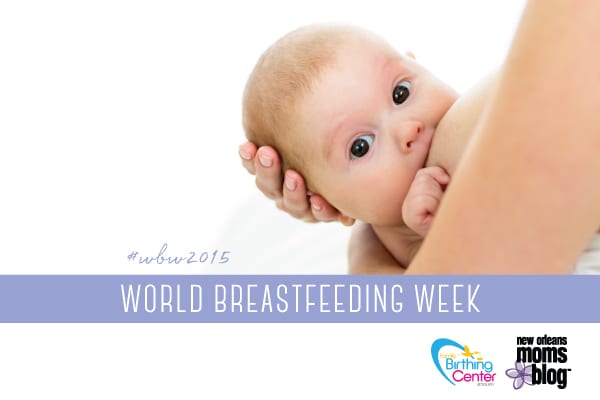Disclosure :: World Breastfeeding Week is recognized August 1-7, 2015. This year, World Breastfeeding Week calls for concerted global action to support women to combine breastfeeding and work. Whether a woman is working in the formal, non-formal or home setting, it is necessary that she is empowered in claiming her and her baby’s right to breastfeed. Our World Breastfeeding Week series is sponsored by Touro Infirmary.
 If you delivered a baby several years ago, your beautiful new arrival may have first been handed to you after being wiped clean and swaddled before you attempted to breastfeed. If you delivered more recently, you may have experienced “skin to skin” contact, placing baby on mom’s chest immediately after delivery. So, why the change?
If you delivered a baby several years ago, your beautiful new arrival may have first been handed to you after being wiped clean and swaddled before you attempted to breastfeed. If you delivered more recently, you may have experienced “skin to skin” contact, placing baby on mom’s chest immediately after delivery. So, why the change?
What is “skin to skin” contact all about?
Studies show that skin to skin contact immediately after birth has many positive effects. Skin to skin contact lasts for at least an hour and should continue for as many hours as possible throughout the day and night for the first number of weeks. Among many other benefits, skin to skin contact is important to establishing breastfeeding. With skin to skin contact, baby is more likely to latch on and to latch on well.
Skin to skin contact allows mom and baby to exchange sensory information that stimulates and elicits rooting and searching for the breast. Other benefits include staying calm, breathing more naturally, staying warm, maintaining baby’s body temperature and blood sugar. Baby is also less likely to cry and is more likely to breastfeed exclusively and breastfeed longer.
 Skin to skin contact immediately after birth also allows the baby to be colonized by the same bacteria as the mother. This, plus breastfeeding, are thought to be important in building a strong, healthy immune system and the prevention of allergic diseases.
Skin to skin contact immediately after birth also allows the baby to be colonized by the same bacteria as the mother. This, plus breastfeeding, are thought to be important in building a strong, healthy immune system and the prevention of allergic diseases.
There is no reason that the vast majority of babies cannot be skin to skin with the mother immediately after birth for at least an hour. Hospital routines, such as weighing the baby, should not take precedence.
Why is skin-to-skin important for breastfeeding?
Holding your baby skin-to-skin helps your body make more milk. Skin-to-skin will help you learn your baby’s cues. It will also increase the level of prolactin you produce. Prolactin is a hormone responsible for helping your body to make milk. Many mothers find that latching their babies is easier when they are held skin-to-skin. It can also calm a fussy baby.
What Should You Expect?
With skin-to-skin contact, your baby should be dried off and placed vertically on your abdomen and chest and be left there to find his or her way to the breast through touch, taste and smell. It is unnecessary to force the baby to the breast; the mother may provide some gentle guidance by holding the baby close and supporting the breast as needed.
The Touro Lactation Center
During your hospital stay, Touro’s lactation consultants are available 7 days a week to help with breastfeeding questions or challenges that require skilled lactation support. The Lactation Center is open for outpatients 9 a.m. – 4 p.m., Monday – Friday, by appointment only to provide breastfeeding support and assistance.
Touro offers a full-service retail store where families can purchase products specifically for breastfeeding needs. The store is conveniently located on the second floor of the hospital near the Family Birthing Center. The Center also offers bra fittings by appointments free of charge and sells breastfeeding products and pump pieces.
To learn more about the Touro Lactation Center, visit their website or call 504-897-8130.
Sources:
About Kimberly Benedict, RN
 Kimberly Benedict RN, BSN, IBCLC, RLC is a board certified lactation consultant with over 20 years of experience helping Touro moms and babies to begin their breastfeeding relationship with loving guidance and support. She is a graduate of LSU School of Nursing and has been employed at Touro since 1989. Kimberly is the proud mom of four healthy, breastfed children.
Kimberly Benedict RN, BSN, IBCLC, RLC is a board certified lactation consultant with over 20 years of experience helping Touro moms and babies to begin their breastfeeding relationship with loving guidance and support. She is a graduate of LSU School of Nursing and has been employed at Touro since 1989. Kimberly is the proud mom of four healthy, breastfed children.
















